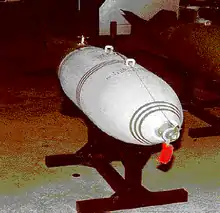MC-1 bomb
The MC-1 bomb was the first U.S. non-clustered air-dropped chemical munition. The 750-pound (340 kg) MC-1 was first produced in 1959 and carried the nerve agent sarin.

History
The MC-1 chemical bomb was first brought into regular mass-production in 1959.[1] A modified general purpose demolition bomb, the MC-1 was the first non-clustered chemical munition in the U.S. arsenal.[1] The MC-1 was designed to be delivered via U.S. Air Force aircraft.[2] The MC-1 was never used against enemy targets.
Specifications
The MC-1 was a 750-pound (340 kg) munition.[1][2] The weapon had a diameter of 16 inches (41 cm) and a length of 50 inches (127 cm).[2] The MC-1 was filled with about 220 pounds (100 kg) of sarin (GB) nerve agent.[2] The MC-1 was designed to be air-dropped via the F-4 Phantom II and was unable to fit that aircraft's replacement, the F-16.[3]
Demilitarization operations
Umatilla Chemical Depot stored about 2,400 MC-1 bombs until the final one was demilitarized and destroyed on June 9, 2006.[4] Another 3,047 MC-1s were stored at Johnston Atoll when demilitarization operations began there in 1990.[5] Those weapons were destroyed during the ensuing decade and operations at Johnston Atoll Chemical Agent Disposal System ended in 2000.[5][6]
Test involving the MC-1
Tests were conducted using the MC-1 from July-November 1971 at Dugway Proving Ground in Utah.[7] The aim of these tests, which were part of Project 112,[8] was twofold. One goal was to determine hazards associated with the accidental release or damage from hostile fire of the MC-1 during takeoff or landing.[7] A second goal was to determine if leak suppressant and disposal procedures for damaged bombs were adequate.[7] For the purpose of the tests the MC-1 was filled with water and a sarin simulant, di(2-ethylhexyl) phthalate (DEHP).[7] The bombs were dropped from an F-4 during the tests.[7]
See also
References
- Smart, Jeffery K. Medical Aspects of Chemical and Biological Warfare Archived 2012-08-26 at the Wayback Machine: Chapter 2 - History of Chemical and Biological Warfare: An American Perspective, (PDF Archived 2015-09-23 at the Wayback Machine: p. 59), Borden Institute, Textbooks of Military Medicine, PDF via Maxwell-Gunter Air Force Base, accessed December 29, 2008.
- Mauroni, Albert J. Chemical Demilitarization: Public Policy Aspects, (Google Books), Greenwood Publishing Group, 2003 pp. 18-19, (ISBN 027597796X).
- Duke, Simon (Stockholm International Peace Research Institute). United States Military Forces and Installations in Europe, (Google Books), Oxford University Press, 1989, pp. 84-85, (ISBN 0198291329).
- Hendrickson, Bruce. "Depot and Disposal Facility reach significant milestones Archived 2008-11-20 at the Wayback Machine", (Press release), Umatilla Chemical Depot, U.S. Army Chemical Materials Agency, June 12, 2006, accessed December 29, 2008.
- Cashman, John R. Emergency Response Handbook for Chemical and Biological Agents and Weapons, (Google Books), CRC Press, 2008, pp. 107-08, (ISBN 1420052659).
- "Chemical Weapons Destruction Complete on Johnston Atoll", (Press release), U.S. Department of Defense, November 30, 2000, accessed December 29, 2008.
- "Fact Sheet — DTC Test 69-14 Archived 2009-08-05 at the Wayback Machine", Office of the Assistant Secretary of Defense (Health Affairs), Deployment Health Support Directorate, accessed November 12, 2008.
- "Project 112/SHAD Fact Sheets Archived 2008-12-20 at the Wayback Machine", Force Health Protection & Readiness Policy & Programs, The Chemical-Biological Warfare Exposures Site, accessed December 29, 2008.